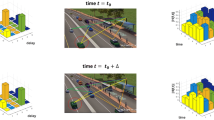Abstract
We present in this paper an approach based on some kind of decision feedback vector equalization, which allows, withofdm modulation, to avoid the insertion of any guard interval. The bit rate that is thus saved may be used to increase efficiently the correction capabilities of the channel decoder and consequently the overall performances of the system. Indeed, over frequency selective channel the proposed scheme outperforms classical solutions (using a guard interval) with up to 3 dB in term of signal to noise ratio. The weak point of this vector equalization approach is of course an increase of the computational complexity, by a factor of about 8. Sub-optimal solutions, relying on sub-channel equalization, may be derived which provide similar complexity as the guard interval approach, however their performance gain is very much reduced, especially for critical channelsi.e with deep fadings). Now, the progress in dsp integration make it possible to envisage in the short term the implementation of the optimal scheme for practical applications, especially when shortffts can be used.
Résumé
Cet article présente une solution basée sur une technique ďégalisation vectorielle avec décision réfléchie, qui permet, dans le cas de la modulationofdm de supprimer les intervalles de garde. Le débit binaire ainsi économisé peut être utilisé pour accroître substantiellement les capacités de correction du décodeur de canal, et donc les performances du système. En fait, sur canal sélectif, cette approche permet ďobtenir (à débit égal) un gain en rapport signal à bruit pouvant atteindre 3 dB, vis-à-vis de la solution habituelle utilisant un intervalle de garde. Le point faible de cette technique réside bien évidemment dans sa complexité de mise en œuvre, environ huit fois plus élevée. Des solutions sous-optimales, reposant sur une égalisation par sous-canaux, peuvent être envisagées. La complexité est alors ramenée à un niveau comparable à celle de ľapproche par intervalle de garde, mais les performances obtenues en sont fortement affectées, notamment sur canal critique (évanouissements profonds). Ľévolution constante de la puissance de calcul des processeurs de traitement de signal permet toutefois ďenvisager à court terme la mise en œuvre de la solution optimale par égalisation vectorielle, en particulier pour des applications ne nécessitant pas un nombre de sous-porteuses trop important.
Similar content being viewed by others
References
Le Floch (B.), Alard (M.), Berrou (C.). Coded orthogonal frequency division multiplexing.Proc. IEEE (1995),83, n° 6, pp. 982–996.
Tourtier (P. J.), Monnier (R.), Lopez (P.). Multicarrier modem for digital hdtv terrestrial broadcasting.Image Communication (1993),5, n° 5–6, pp. 379–404.
Tourtier (P. J.),Monnier (R.),Lopez (P.). Digital audio broadcasting (dab) to mobile, portable and fixed receivers. European Telecommunication Standard.ETSI (Feb. 1995).
Tourtier (P. J.),Monnier (R.),Lopez (P.). Digital broadcasting systems for television, sound and data services; framing structure, channel coding and modulation for digital terrestrial television.European Telecommunication Standard. Draft version (May 1996).
PéCOT (M.). Comparaison des approches multiporteuse et monoporteuse pour la diffusion numérique terrestre.GRETSI (1995), pp. 561–564.
Fliege (N. J.). Orthogonal multiple carrier data transmission.European Transactions on Telecommunications (May 1992), 3, n° 3.
Le Floch (B.),Helard (J. F.),Castelain (D.),Rivière (M.). Démodulation cohérente du système de transmission multiporteuse cofdm dans un canal radio mobile.GRETSI (1991), pp. 413–416.
Stott (J. H.), cofdm: the use of pilot cells with boosted power.dTTb contribution (1995).
Mignone (V.), Morello (A.). cd3-ofdm, a novel demodulation scheme for fixed and mobile receivers.IEEE Trans. COM (1996),44, n° 9, pp. 1144–1151.
Weinstein (S. B.), Ebert (P. M.). Data transmission by frequency division multiplexing using the discrete Fourier transform.IEEE Trans. COM Techn. (1971),19, n° 5, pp. 628–634.
Hirosaki (B.). An analysis of automatic equalizer for orthogonally multiplexed qam systems.IEEE Trans. COM (1980),28, n° 1, pp. 73–83.
Koppelaar (A. G. C.),Baggen (C. P. M. J). Proposal for a subchannel equalizer.dTTb contribution (1993).
Qureshi (S.). Adaptive equalization.Proc. IEEE (1985),73, n° 9, pp. 1349–1387.
Author information
Authors and Affiliations
Corresponding author
Rights and permissions
About this article
Cite this article
DéMoulin, V., PéCOT, M. Vector equalization: an alternative approach for OFDM systems. Ann. Télécommun. 52, 4–11 (1997). https://doi.org/10.1007/BF03001044
Received:
Issue Date:
DOI: https://doi.org/10.1007/BF03001044
Key words
- Equalizer
- Vector method
- Frequency division multiplexing
- Orthogonal signal
- Multichannel transmission
- Decision feedback
- Multipath propagation




